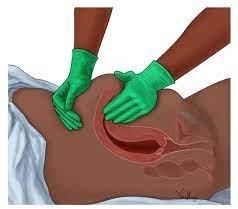A nurse is reviewing the results of a 1-hr glucose screening test for a client who is at 24 weeks of gestation. The client's glucose value is 130 mg/dL. Which of the following actions should the nurse take?
Schedule the client for a routine 1-month appointment.
Instruct the client to return for a 3-hr oral glucose tolerance test.
Have the client perform home glucose monitoring for 1 week.
Repeat the 1 hr glucose testing in 1 week.
The Correct Answer is B
A) Incorrect- Scheduling a routine 1-month appointment is not appropriate given the elevated glucose value. A 1-hour glucose screening test value of 130 mg/dL indicates an elevated glucose level, which suggests the need for further testing to confirm or rule out gestational diabetes.
B) Correct - An elevated glucose value on the initial screening test requires confirmation through a more comprehensive test, such as the 3-hour oral glucose tolerance test.
C) Incorrect- Home glucose monitoring might be indicated for gestational diabetes but is not the next step after an elevated 1-hour glucose screening test.
D) Incorrect- Repeating the 1-hour glucose test in 1 week is not necessary; if the initial test is elevated, further testing is required.
Nursing Test Bank
Naxlex Comprehensive Predictor Exams
Related Questions
Correct Answer is D
Explanation
Rationale:
A) Incorrect - Applying oxygen is not the priority action in the case of excessive vaginal bleeding and a boggy uterus. Oxygen therapy would be appropriate if there were signs of respiratory distress or decreased oxygen saturation, but it does not directly address the primary concern of uterine atony and bleeding.
B) Incorrect - Administering methylergonovine might be appropriate, but the priority is to address the uterine atony with fundal massage first. Fundal massage helps stimulate uterine contractions and control bleeding, which is crucial in this scenario.
C) Incorrect - Encouraging the client to empty her bladder is important, but it is not the first action to take in the case of excessive bleeding and uterine atony. Immediate intervention to control the bleeding takes precedence.
D) Correct - Initiating fundal massage is the priority action in this situation. A boggy uterus with excessive vaginal bleeding indicates uterine atony, which is a potentially life-threatening condition requiring immediate intervention to prevent further bleeding.
Fundal massage helps the uterus contract and control bleeding. Addressing uterine atony is critical to prevent further hemorrhage and stabilize the client's condition.

Correct Answer is ["B","C","E"]
Explanation
A) Incorrect- Dry, cracked skin is not typically associated with a newborn born at 43 weeks of gestation. It's more common in post-term babies.
B) Correct - Hypotonia (low muscle tone) is a possible finding in post-term newborns due to the aging placenta and potential decrease in amniotic fluid.
C) Correct - Excessive lanugo (fine, downy hair) is more likely to be present in post-term babies as they have less vernix to protect their skin.
D) Incorrect- Absent vernix might be more characteristic of a post-term newborn, but its presence or absence varies widely.
E) Correct - Long, hard nails can be a characteristic of post-term babies, as they have had more time for nail growth in the womb.
Whether you are a student looking to ace your exams or a practicing nurse seeking to enhance your expertise , our nursing education contents will empower you with the confidence and competence to make a difference in the lives of patients and become a respected leader in the healthcare field.
Visit Naxlex, invest in your future and unlock endless possibilities with our unparalleled nursing education contents today
Report Wrong Answer on the Current Question
Do you disagree with the answer? If yes, what is your expected answer? Explain.
Kindly be descriptive with the issue you are facing.
